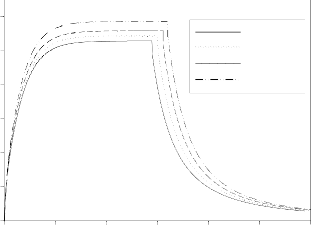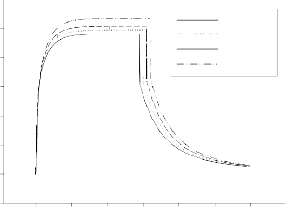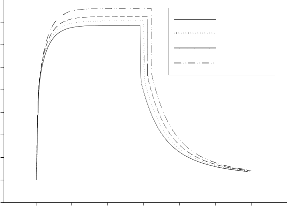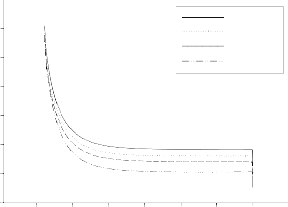International Journal of Scientific & Engineering Research Volume 4 , Issue 12 , December 2013
ISSN 2229 – 5518 2054
Transient Analysis of Two-Phase Closed
Thermosyphon (TPCT) Using AL2O3 Nanofluid
Loula A. Shouman, M. Abd El-Aziz, Adel Alyan Fahmy
Atomic Energy Authority, Reactors Department, 13759 Cairo, Egypt
bidosalem2@yahoo.com
Abstract: A theoretical model is developed to predict the dynamic behavior of TPCT in transient conditions. Al2O3/water nano- fluid is used as a working fluid with three different concentrations (1, 2 and 4%) by volume. The various transient paramete rs during operation from start up to shutdown condition are calculated to present the performance of the TPCT with nano-fluids. The model evaluated the average wall and fluid temperature distribution with time. The average evaporator heat transfer
coefficient, overall heat transfer coefficient, effective thermal conductivity and thermal resistance of TPCT are presented. Also
the effects of changing the nano-fluid concentration on all these parameters are studied. According to the model results, the performance of the TPCT increases compared with pure water. The different parameters increase about 10% with increasing
IJ————S—————— E———————R———
nano-fluid concentration.
he two-phase closed thermosyphon (TPCT), which is essentially a gravity-assisted wickless heat pipe, utilizes the evaporation and condensation of the working fluid
inside the heat pipes to transport heat. A TPCT uses gravity to
return the condensate to evaporator. Its position is not restricted and it may be used in any orientation [1]. The TPCT has a simple structure, smaller thermal resistance, higher efficiency and lower fabrication costs. Given these advantages, the TPCT has been widely used in many fields, such as industrial heat recovery, electronic component and turbine blade cooling, solar heating systems and so on [2].
Many of these applications would benefit from a decrease in the thermal resistance of the heat-transfer fluid. Most commonly used working fluids in TPCTs are water; methanol; ethylene glycol (EG) and their mixtures which are originally poor heat transferring fluids. Since thermal conductivity of these fluids plays an important role in these energy efficient heat transfer equipments, numerous techniques have been introduced to improve it. Because of higher thermal conductivity of solids compared to those of liquids, Consequently fluids with nano-sized particles suspended in them which later called nano-fluids has been proposed by [3]. From the Argonne National laboratory, USA.
By suspending nano-sized particles in a fluid, its heat transfer performance can be significantly improved with incurring either little or no penalty in pressure drop.
Since, a lot of researches have been carried out studies on the heat transfer characteristics of nano-fluids. The heat transfer characteristics of nano-fluids started with the investigation of thermal conductivity [4-5], then the single- phase flow heat transfer [6-8]. The focus mainly is on the phase-changing heat transfer of nano-fluids. Among the phase-changing heat transfer, the application of nano-fluids in heat pipes gains increasing popularity.
The involved heat pipes include the grooved heat pipe [9-10], wicked heat pipe [11-12], oscillated heat pipe [13-
14], and the thermosyphon [15-20].
Xue et al. [15] studied the heat transfer performance of carbon nano-tube-water nano-fluid in a thermosyphon The mass concentration of nano-particles is 1.3158 wt.%. The thermosyphon is a copper tube with an outer diameter (O.D.) of 20 mm. The filling ratio is 20%. Results show that the thermosyphon with carbon nano-tube nano-fluid has a higher evaporation section wall temperature, incipience temperature, and excursion, as well as thermal resistance. The carbon nano- tube-water nano-fluid deteriorates the heat transfer of the thermosyphon compared with the water case.
IJSER © 2013 http://www.ijser.org
International Journal of Scientific & Engineering Research Volume 4 , Issue 12 , December 2013
ISSN 2229 – 5518 2055
Khandekar et al. [16-17] investigated the overall thermal resistance of a closed two-phase thermosyphon using
water-based Al2O3 (40 to 47 nm), CuO (8.6 to 13.5 nm), and laponite clay (disks with a diameter of 25 nm and thickness of
1 nm) nano-fluids. The length and the inner diameter of the thermosyphon are 720 and 16 mm, respectively. The nano- particle mass concentration is 1.0 wt.%. Results show that all nano-fluids have inferior thermal performance compared to pure water. A mechanism analysis guesses that the increase in wettability and entrapment of nano-particles in the grooves of the surface cause a decrease of the Peclet number in the evaporator side and finally leads to poor thermal
performance.
Noie et al. [18] studied the Al2O3-water nano-fluid in a thermosyphon. The thermosyphon is made of a copper tube with an inner diameter of 20 mm and a length of 1,000 mm. The length of the evaporator and the condenser is 350 and 400 mm, respectively. The nano-particle volume concentration is
1% to 3%. Results show that the nano-fluid can enhance the
heat pipe efficiency by 14.7%, and the thermosyphon shows a
A model has been performed to describes the thermal and phase flow of closed two-phase thermosyphon (TPCT). This model presents a theoretical investigation of thermosyphon behavior in the transient regime. The transient model was adopted to simulate the response of thermosyphon with pure water and nano-fluid with different concentrations. The transient thermal behavior of (TPCT) has been utilized to obtain a mathematical expression of the system response. Figure (1) show TPCT, which is basically divided axially into three basic regions: evaporator (heating), adiabatic (thermally insulated) and condenser (cooling) sections. The thermosyphon main tube made of copper with 26 mm inner diameter, 1 mm thickness and 970 mm long. The evaporator and condenser section lengths are 550 mm and 250 mm respectively, while the adiabatic section is 170 mm long. Individually, each region is mathematically and thermally treated due to variation of the heat transfer processes. In addition, the evaporator region is filled of a liquid (filling
ratio=1). When the power is on, the heat generated in the
IJSER
more uniformly distributed temperature.
Paramatthanuwat et al. [19] studied the heat transfer of Ag-water nano-fluid in a thermosyphon. The effects of filling ratio (30%, 50%, 80%), the operating temperature (40°C,
50°C, 60°C), the ratio of length and diameter (5,10, 20), and the
diameter (7.5, 11.1, and 25.4 mm) on the heat transfer performance were investigated in detail. Results show that the heat transfer capacity can be enhanced by 70% by adding Ag nano-particles.
Teng et al. [20] studied the heat transfer performance of the Al2O3-water nano-fluid (mass concentrations of 0.5%,
1.0%, and 3.0%). The thermosyphon is made of a copper tube
with an inner diameter of 8 mm and a length of 600 mm. The
authors investigated the effects of inclination, filling ratio, and mass concentration on the heat transfer performance. The thermosyphon efficiency can be enhanced by 16.8% at the mass concentration of 1.0%.
It is obvious from the previous studies that, most investigations focus on the experimental performance characteristics of TPCT with nano-fluid. Therefore, it was seen appropriate to indulge in a theoretical transient study, which
heater is rising its temperature with time. The heat transferred
to the wall causing its temperature to rise and with time
transfer the heat to the liquid. On reaching the saturation temperature, any heat added causes the saturated fluid to evaporator. Then the heat rate is carried by the vapor flows from evaporator to condenser, which is rejected to the heat sink. The model is analyzed in one-dimension, where the axial coordinate x is mainly measured from the evaporator bottom.
A model describing both thermal and phase flows of the TPCT has been performed by Farsi,etal [21]. It is based on a spatial discretization similar to that proposed by Reed and Tien [22] and Dobran [23]. A thermal model has been derived from the previous model. This simple model has been developed in order to provide analytical expressions of the variables in the system. On the other hand, to give an expression of the TPCT response time as a function of the various parameters. The heat balance equation for each wall and fluid give:
could predict the behavior of DTT from startup, the steady
d
C T Q
h S (T
T )
(1)
state to shutdown condition. The main objective of the current study is to develop a theoretical model that can predict the dynamic behavior of the TPCT by tracing various transient parameters during operation from start up to shutdown![]()
w dt w e e e w f
d
condition.![]()
C f T f
dt
he S e (Tw T f ) hc S c (T f
Twat )
(2)
The solution of the above equations is obtained by
IJSER © 2013 http://www.ijser.org
International Journal of Scientific & Engineering Research Volume 4 , Issue 12 , December 2013
ISSN 2229 – 5518 2056
using finite difference -Euler method in step of t. The solution leads to the following expressions of the average
he
0.00122 * T 0.24 * P 0.75 * c p 0.45 * 0.49 * k 0.79
(8)
evaporator wall temperature and the average fluid![]()
0.5 * H
0.24 * 0.29 * 0.24
temperature respectively:
fg l g
n 1
Cw (Tw
T n ) t * Q t * h S (T n 1
Tf
n 1
)
(3)
The average heat transfer coefficient between the condenser surface and cooling water can be calculated in the
C (T n 1 T n ) t * he Se (T n 1 T n 1) t * hc Sc (T n 1 Twat )
case of laminar and turbulent flow regimes [25] respectively
f f f
![]()
T n 1 C B *T f
w
n 1
f f
(4)
(5)
as:
For laminar
hcw =1.86(Re. Pr)cw0.33(dh/Lc)0.33(cw/)0.14(kcw/dh)
w A
For turbulent
(9)
![]()
F D *C
T n 1 A
(6)
hcw =0.023(Re cw )0.8 (Pr cw)0.33 (kcw/dh) (10)
![]()
f D * B E
A
Where, the flow is assumed as turbulent at Recw 3000,
.
4 m
Where these constant are:
Recw
![]()
cw
IJSER d h cw
A Cw t * he * Se
B t * he * Se
C t * Q C *T n e w w
D he * Se * t
The performance of the thermosyphon can be hypothetically expressed by an overall heat transfer coefficient. The equivalent overall heat transfer coefficient is calculated from
E C f
t * he * Se t * hc * Sc
n
the following equation:
U = qax / Ti (11)
F C f *Tf
t * hc * Sc *Twat
Equation (5) and (6) depend mainly on the nine variables Q, Cw, Cf, Se, Sc, he, hc, Tw and t.
The net hear load is accurately calculated by the rate of the heat removal in the cooling jacket of the condenser as a following:
Q = [m*Cp*(To-Ti)]cw (7)
The temperature difference T between the mean evaporator
and condenser inner wall regions, is given as:
Ti = Twe - Twc (12)
Effective thermal conductivity is an appropriate
means for measuring the performance of two-phase closed thermosyphon. TPCT can achieve high thermal conductivity due to liquid vapor phase change to transport heat from evaporator to condenser section. The effective thermal conductivity can be evaluated by the following relation as:
The process of the heat transfer in the liquid pool of
K = q
*Lp / Ti (13)
the thermosyphon generally assumed as a common nucleate boiling. The nucleate boiling heat transfer coefficient calculated from Forester-Zuber equation [24]:
eff ax
Where:
Lp = 1/2(Le+Lc) + Lad
IJSER © 2013 http://www.ijser.org
International Journal of Scientific & Engineering Research Volume 4 , Issue 12 , December 2013
ISSN 2229 – 5518 2057
The thermal resistance of thermosyphon with pure![]()
![]()

water and different nano-fluids, where calculated by the following relation:
Rth = (Te – Tc) / Q (14)
Where, Te and Tc are average values of the evaporator and condenser temperatures.
The thermosyphon operation is based on vaporization and subsequent condensation of the working fluid. So, the properties of working fluid have effect in the performance of TPCT. Thermophysical properties including the thermal conductivity, the viscosity, and the surface tension of nano- fluid have been introduced by S.Lee, et al. [26].
The density of nano-fluids is calculated as:![]()
![]()
![]()
![]()
![]()
![]()
![]()
![]()
![]()
![]()
![]()
![]()
![]()
Liquid Pool
![]()
![]()
![]()
![]()
![]()
![]()
IJSER
![]()
![]()
ρnf = ρnp* ϕ + ρl (1 − ϕ ) (15)
![]()
![]()
The specific heat of nano-fluids is calculated as:
![]()
![]()
![]()
cpnf = cpnp*ϕ + cpl (1 − ϕ ) (16)
The thermal conductivity of nano-fluids is evaluated as:
knf = kl (1 +7.4* ϕ ) (17)
The viscosity of nano-fluids is calculated from following correlation:
µnf = µl (1 +2.5* ϕ ) (18)
The latent heat of nano-fluids is the same as that of water.
A computer simulation program based on the method was developed to estimate temperatures and the other parameters of the thermosyphon. The equations are solved by Engineering Equation Solver program (ESS).
Fig. (1) A Schematic of Two-Phase Closed Conventional Thermosyphon.
The results describing the time-dependent behavior of the thermosyphon during transient operation of start-up from initial conditions to steady state and shutdown are basically discussed and analyzed. These result analyze the average wall and fluid temperature distribution for the various thermosyphon operation stages. The average evaporator heat transfer coefficient, overall heat transfer coefficient, effective thermal conductivity, thermal resistance of TPCT are presented. Also the effects of changing the nano-fluid concentration on all these parameters were studied.
Figure (2) illustrates the distribution of the transient average wall and fluid temperatures through heat up, steady state and shutdown. At the beginning of the heating process, the heat transfers first to the evaporator wall of the thermosyphon. The wall temperatures increase from the ambient temperature with time and it begins to transfer heat to the fluid. With time the fluid temperature rises along the pool region in the evaporator and starts to evaporated.
IJSER © 2013 http://www.ijser.org
International Journal of Scientific & Engineering Research Volume 4 , Issue 12 , December 2013
ISSN 2229 – 5518 2058
concentration. As shown from the figure, the evaporating
HTC of nano-fluid increases maximally by 12% at the
The wall and fluid temperature increase to certain value and 70
when all temperatures are constant the TPCT reach to steady
state. Following the period of steady state, the shutdown is 65
Tw for water
Tw for AL O 1%
2 3
initiated by the power is off. The wall and fluid temperature 60
decrease during shut down until reach to the ambient
temperature. 55
The effect of several concentration levels were 50
investigated on the thermosyphon wall temperature variation. 45
As shown in the figure, the temperature changes with
different nano-particle concentration. By increasing the nano- 40
particle concentration, the temperature gradient in evaporator
becomes less. This happens mainly due to the direct relation of 35
particles concentration with the nano-fluid thermal
30
Power = 1000 W Mcw = 0.04 Kg/s
Tw for AL2O3 2% Tw for AL2O3 4% Fluid temperature
conductivity. As the particle concentration raises (i.e. effective
thermal conductivity of the working fluid increases) the
temperature amplitude drops in the evaporator section. This happens owing to the higher heat flux passes through TPCT as the fluid thermal conductivity increases.
0 1,000 2,000 3,000 4,000 5,000 6,000
Time, sec
Fig. (2)Transient Average Outer Wall and fluid Temperature at Different Nanofluid Concentration.

The calculated average evaporator heat transfer coefficient is plotted in figure (3). With the time for the different transient operations. Throughout the heat-up phase,
he increases gradually from the bottom to the top of the
evaporator. The wall/working fluid temperature increase gradually forming the bubble nuclei. While the fluid temperature increases with time the bubbles has a higher intensity near the free surface of the liquid pool. The increase of the bubble movement leads to increase of the evaporator heat transfer coefficient. At steady state, all temperatures are constant that the evaporator heat transfer coefficient of the TPCT constant with time. When the shutdown is initiated, wall and fluid temperature decrease and according to that the evaporator heat transfer coefficient decreases with time.
The figure also represents the effect of concentration levels on average evaporator HTC. During nucleate pool
3000
2500
2000
1500
1000
500
0
Power = 1000 W M. = 0.04 kg/s.
Water AL2O3 1% AL2O3 2% AL2O3 4%
boiling, the single-phase convective transport is patently
affected by many complementary effects such as bubble departure diameter and frequency, nucleation site density and the average rise velocity of individual bubbles. Generally, the bubble formation is related to the surface wettability and roughness. It is cleared from previous study about nano-fluid boiling that the nano-particles changed the surface condition of the evaporator section. The sizes of nano-particles are
smaller than the cavities of the clean surface. Then, the Al2O3 nano-particles that may deposit on nucleation sites could create more new active nucleation sites by splitting a single nucleation site into multiple ones and enhanced the boiling heat transfer. Beside this, the irregular nano-pores formed
between deposited Al2O3 nano-particles would affect the bubble diameter and release frequency, and then bubbles may be continuously generated. Therefore, the average heat transfer coefficient increases with the nano-fluid
0 1000 2000 3000 4000 5000 6000
Time, (sec.)
Fig. (3). Transient Average Evaporator Heat Transfer Coefficient at Different Nanofluid Concentration.
operating temperature of 65°C. The transient condenser heat transfer coefficient is evaluated at different nano-fluid concentrations. As shown in figure (4), the nano-fluid concentration has little effect on the condenser heat transfer coefficient. This effect is due to that, when the nano-fluid evaporates the nano-particles aren’t transported upwards in the condenser zone by the vapor inertia. But the fact that even micron sized pollutant particulates do not settle down for extended periods in the atmosphere strongly indicates that the possibility of nano-particle transport in the condenser section cannot be ruled out. According to the above discussion, nano-
IJSER © 2013 http://www.ijser.org
International Journal of Scientific & Engineering Research Volume 4 , Issue 12 , December 2013
ISSN 2229 – 5518 2059
fluid can enhance the evaporating HTC of the thermosyphon but has no effect on the condensing HTC. The heat transfer characteristics of nano-fluid result mainly from the changes of
3e+5
3e+5
Water
AL O 1%

2 3
1552
2e+5
AL2O3 2% AL O 4%
1550
1548
1546
Water AL2O3 1% AL2O3 2% AL2O3 4%
2 3
2e+5
1e+5
1544
1542
1540
1538
1536
Power = 1000 W
cw= 0.04 kg/s.
5e+4
0
-5e+4
Power = 1000 W M. = 0.04 kg/s.
0 1000 2000 3000 4000 5000 6000 7000
Time, (sec.)

1534
0 1000 2000 3000 4000 5000 6000 7000
Time, (sec.)
Fig. (5). Transient Overall Heat Transfer Coefficient of the Thermosyphon at Different Nanofluid Concentration.
As can be seen from this equation that the effective
Fig. (4). Transient Average Condenser Heat Transfer Coefficient
at Different Nanofluid concentration.
thermal conductivity of thermosyphon is not referred to, the working fluid nor the pipe metal thermal conductivity. It
IJSER
the thermo physical properties of nano-fluids. The overall heat
transfer coefficient is plotted in figure (5) viruses the time for heat up , steady state and shutdown. As shown in the figure, there is a direct relation between the overall heat transfer coefficient and heat transfer rate. Although, the temperature difference Ti increases with the time, as the heat flux increase, however, the temperature difference increases considerably less than the increase in the rate of heat transfer. This means that the rate of change in the heat flux is relatively higher than the rate of increase of temperature difference (Ti). Consequently, the equivalent overall heat transfer coefficient increases at heat-up region. At steady state, the overall heat transfer coefficient is constant for period of time. when power is off at shutdown, the heat transfer rate from evaporator to condenser decreases and also the overall heat transfer coefficient.
Also the figure illustrates the relation between the
overall heat transfer coefficient and the nano-fluid concentration, the increase of nano-fluid concentration from 1 to 4 % increase the overall heat transfer coefficient by nearly
11%.
mainly depends on the heat flow and the dimensions of the
thermosyphon. Figure (6) presents the variation of the
effective thermal conductivity of the TPCT versus time. As it is observed from the figure, the effective thermal conductivity is extremely dependent on the heat flow rate, where it increases with heat transferred that increase with time. At steady state condition the effective thermal conductivity of thermosyphon is constant with the constant heat load and temperatures. At shut down, the effective thermal conductivity is decreasing due to the power off and therefore, the heat transferred from evaporator to condenser decreases.
The figure also shows the relation between the effective thermal conductivity and the nano-fluid concentrations at constant heat load and constant cooling water flow rate. It was shown that, effective thermal conductivity is increased by 10% during increasing in the nano-fluid concentrations. The increase of the effective thermal conductivity is referred to the increase in the thermal conductivity of the working fluid.
The effect of nano-particles on two-phase flow heat transfer enhancement may be illustrated through two reasons; the suspended nano-particles increased the thermal conductivity of base fluid and the interactions among the nano-particles itself on one hand and between nano-particles and the inner surface of the thermo syphon. These reasons increase the heat transfer rate in evaporator and from evaporator to condenser. Therefore the increasing of nano- particle concentration causes an increasing in the overall heat transfer coefficient.
In comparison with the thermal conductivity of
copper and silver the thermal conductivity of the
thermosyphon (water fluid) is more than 300 folds higher than that for copper and silver. With added the nano-particle to the fluid, the thermal conductivity of the TPCT reaches more than
350 folds higher than that for copper. This can be explained by the principle of phase change in thermosyphon. This clearly shows the thermosyphon has the capability to transport a high amount of heat energy.
The thermal resistances of the TPCT using both the water and nano-fluids are represented in the transient
IJSER © 2013 http://www.ijser.org
International Journal of Scientific & Engineering Research Volume 4 , Issue 12 , December 2013
ISSN 2229 – 5518 2060
operation in Fig. (7).
Thermal resistance is evaluated at the different stages of the operation of the TPCT from heating up, steady state and shutdown. The results show that, the decrease of the thermal
1.6e+5
1.4e+5
1.2e+5
Water
AL2O3 1% AL O 2%
2 3
resistance with time and with increasing the nano-fluid
AL O 4%
concentration. To interpret the thermal resistance decreasing with nano-fluid concentration increasing, it may be said that the total thermal resistance of a TPCT between evaporator and condenser section consisted of thermal resistance in the thermosyphon wall, the thermal resistance due to evaporation and condensation (evaporator and condenser sections) and the thermal resistance in the two-phase flow through heat TPCT length. The wall thermal resistance is independent of the working fluid. Thermal resistances at the evaporator and
1.0e+5
8.0e+4
6.0e+4
4.0e+4
2.0e+4
0.0
-2.0e+4
2 3
Power = 1000 W
cw= 0.04 kg/s.

condenser sections were influenced by several parameters,
such as surface condition of thermosyphon inner wall. Considering previous discussion about nano-fluid and boiling heat transfer coefficient, one can be found that thermal resistance at Evaporator section decreased because of increasing liquid thermal conductivity, density, active nucleation site density, bubble release diameter and frequency. on the other hand, also, the diffusion and collision
0 1000 2000 3000 4000 5000 6000 7000
Time, (sec.)
Fig. (6). Transient Effective Thermal Conductivity of the Thermosyphon at
Different Nanofluid Concentration.

0.013
Water
intensification of nano-particles in nano-fluid near duct wall
0.012
AL2O3 1%
due to increase in concentIration Jof nano-parSticles leads to ER
AL2O3 2%
rapid heat transfer from wall to nano-fluid. The increase in heat transfer with the nano-fluid concentration leads to the
0.011
0.010
Power = 1000 W
AL2O3 4%
decrease in the thermal resistance of thermosyphon.
The transient thermal performance of TPCT using
Al2O3/water nano-fluid as the working fluid under different concentrations was theoretically studied. Different performance parameters are calculated to evaluate the advantage of using Nano-fluids. The results indicated that,
0.009
0.008
0.007
0.006
M cw= 0.04 kg/s.
0 500 1000 1500 2000 2500 3000 3500
Time, (sec.)
temperature distributions on the TPCT were lower level using
nano-fluid compared to pure water. Heat transfer coefficients
and thermal conductivity are enhancement about 12% with
increasing nano-fluids concentration. The thermal resistance of the TPCT was less when nano-fluids concentration increases. The higher thermal performance TPCTs loaded with nano-fluid proved its potential as substitute for conventional
Fig. (7). Transient Thermosyphon Thermal Resistance of at Different
Nanofluid Concentration.
A Cross section area (m2),
ones with pure water. This finding makes nano-fluid attractive C
as working fluid in heat pipe and thermosyphon technology. p
specific heat (J/kg. oC),
h heat transfer coefficient (W/m2.oC) hfg latent heat of vaporization ( j/kg.oC) k thermal conductivity (W/m oC),
keff effective thermal conductivity (W/m oC),
IJSER © 2013 http://www.ijser.org
International Journal of Scientific & Engineering Research Volume 4 , Issue 12 , December 2013
ISSN 2229 – 5518 2061
P pressure (N/ m2 ), q heat flux (W/m2), Q heat load (W),
S radial surface area,(m2)
T temperature (oC),
T temperature difference (oC),
Ueq equivalent overall heat transfer coefficient (W/ m2 oC),
Greek Symbols
β thermal expansion coefficient(K-1)
nano-fluid concenItrationJ, SER
dynamic viscosity (N.s/m2)
density(kg/m3),
surface tension (N/m),
Pr Prandtl number (Cp /k),
Re Reynolds number (4q L/hfg ).
Subscripts
[1] T. Payakaruk, P. Teedtoon, S. Ritthidech, ―Correlation to
predict heat-transfer
characteristic of an inclined closed two-phase thermosyphon
at normal operating conditions‖, Appl. Therm. Eng. 20 (2000)
781–790.
[2] S. Khandekar, Y.M. Joshi, B. Mehta, ―Thermal
performance of closed two-phase
thermosyphon using nano-fluid‖, Int. J. Therm. Sci. 47 (2008)
659–667.
[3] Choi SUS: ―Enhancing thermal conductivity of fluids with
nanoparticles‖. J.ASME FED 1995, 231:99. Choi (1995)
[4]. Eastman JA, Choi SUS, Li S, Yu W, Thompson LJ:
―Anomalously increased effective thermal conductivities of ethylene glycol-based nanofluids containing copper nanoparticles‖. Appl Phys Lett 2001, 78:718-720.
[5]. Das SK, Putra N, Thiesen P, Roetzel W: ―Temperature
dependence of thermal conductivity enhancement for
nanofluids‖. J Heat Trans 2003,125:567.
[6]. Xuan Y, Li Q: ―Heat transfer enhancement of nanofluids‖.
J Heat Trans 2003, 125:151.
[7]. Putra N, Roetzel W, Das SK: ―Pool boiling characteristics of nanofluids. Heat and Mass Transfer‖. 2003, 39:775.
[8]. Wen D, Ding Y: ―Experimental investigation into
convective heat transfer of nanofluids at the entrance region under laminar flow conditions‖. Int J. Heat Mass Tran 2004,
47:5181.
[9]. Kang SW, Wei WC, Tsai SH, Yang SY: ―Experiment investigation of silver nano-fluid on heat pipe thermal performance‖. Appl Therm Eng 2006,26:2377.
[10] Shafahi M, Bianco V, Vafai K, Manca O: ―Thermal performance of flat shaped heat pipes using nanofluids‖. Int J Heat Mass Tran 2010, 53:1438.
IJSER © 2013 http://www.ijser.org
International Journal of Scientific & Engineering Research Volume 4 , Issue 12 , December 2013
ISSN 2229 – 5518 2062
[11] Tsai CY, Chien HT, Ding PP, Chan B, Luh TY, Chen PH:
―Effect of structural character of gold nanoparticles in nano- fluid on heat pipe thermal Performance‖. Mater Lett 2004,
58:1461.
[26] S. Lee, S.U.S Choi, S. Li., and J.A. Eastman, "Measuring thermal conductivity of fluids containing oxide nanoparticles," J. Heat Transfer vol. 121, 1999, pp. 280-289.
[12]. Chen YT, Wei WC, Kang SW, Yu CS: ―Effect of
nanofluids on flat heat pipe
thermal performance‖. The 24th IEEE Semiconductor Thermal
Measurement and Management Symposium, IEEE: March 16-
20 2008; San Jose 2008, 16-19.
[13]. Ma HB, Wilson C, Borgmeyer B, Park K, Yu Q, Choi SUS,
Tirumala M: ―Effect of nano-fluid on the heat transport
capability in an oscillating heat pipe‖. Appl Phys Lett 2006,
88:143116.
[14]. Lin YH, Kang SW, Chen HL: ―Effect of silver nano-fluid on pulsating heat pipe thermal performance‖. Appl. Therm. Eng 2008, 28:1312
[15]. Xue H, Fan J, Hu Y, Hong R, Cen K: ―The interface effect of carbon nanotube suspension on the thermal performance of a two-phase closed thermosyphon‖. J Appl. Phys. 2006,
100:104909.
[16]. Khandekar S, Joshi YM, Mehta B: ―Thermal performance
of closed twophase
thermosyphon using nanofluids‖. Int. J Therm. Sci. 2008,
47:659.
[17]. Mehta B, Khandekar S: ―Embedded pulsating heat pipe radiators‖. 14th
International Heat Pipe Conference (14th IHPC): April 22-27
2007; Florianopolis
2007.
[18]. Noie SH, Heris SZ, Kahani M, Nowee SM: ―Heat transfer
enhancement using
Al2O3/water nano-fluid in a two-phase closed
thermosyphon‖. Int. J Heat Fluid Fl 2009, 30:700.
[19]. Paramatthanuwat T, Boothaisong S, Rittidech S, Booddachan K: ―Heat transfer characteristics of a two-phase closed thermosyphon using deionized water mixed with silver nano‖. Heat Mass Transfer 2010, 46:281.
[20]. Teng TP, Hsu HG, Mo HE, Chen CC: ―Thermal efficiency
of heat pipe with
alumina nano-fluid‖, Journal of Alloys and Compounds 2010,
504S:380.
[21] H. Farsi, Jean-Louis Joly, M. Miscevic, V. Platel and N.
Mazet ― An experimental and theoretical investigation of the transient behavior of a two-phase closed thermosyphon‖. Applied thermal engineering 23 ( 2002) 1895-1912.
[22] J.G. Reed, C.L. Tien, ―Modeling of the two-phase closed
thermosyphon‖, Transactions of the ASME 109 (1987) 722–730.
[23] F. Dobran, ―Steady-state characteristics and stability
thresholds of a closed two-phase thermosyphon‖, Int. J Heat
Mass Transfer 28 (5) (1985) 949–957.
[24] P. B. Whalley, ―Boiling condensation and gas-liquid
flow‖, Deprtement of Engineering Science, University of
Oxford,1989.
[25] Frank P. Incropera and David P Dewitt,‖ Introduction of heat transfer ― John Willy & Sons, Inc., New York ,1985.
IJSER © 2013 http://www.ijser.org